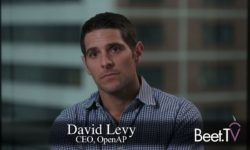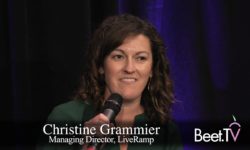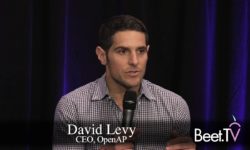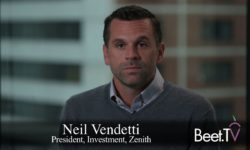What is the future of TV advertising, now that buyers can deliver targeted campaigns to connected television devices, as well as to traditional linear audiences?
That is what a panel of industry executives gathered to discuss at Beet Retreat In The City:
- Amobee – Philip Smolin, chief strategy officer
- FreeWheel – Joy Baer, president, FreeWheel Advertisers
- ZenithOptimedia – Nick Hartofilis, EVP, national video activation
They were questioned by Jon Watts, partner at TV industry consulting firm MTM…
Zenith buyer bullish
Hartofilis said he doesn’t see the barriers to delivery that many industry executives often observe.
“Essentially, all the ingredients (to do that) are there,” he said. “We’re talking about data platforms, measurement, sciences, all those ingredients are there. It’s just a matter of having the right plan there to put it all to work. I’m actually in the stage now where I’m very bullish on a lot of this.”
Agencies stuck in Excel?
But that same optimism for and embrace of new converged buying techniques isn’t universal.
“The concepts of incremental reach and being able to really measure meaningful audiences outside of just (a) linear television buy, for example, is very real and moving in the right direction,” said FreeWheel’s Baer.
“But we still have a lot of clients who are working with Excel spreadsheets.”
Amobee’s Smolin echoed that sentiment. “There are definitely some leaders in the space and there are a lot of laggards in the space within kind of the agency ecosystem from our perspective,” he said.
TV effectiveness diminishing
Broader TV audience and economics shifts may prompt evolution of converged OTT and linear ad buying.
“TV does some things really, really well… But the economics are diminishing every year and with good reason,” Hartifilis said. “Our clients are under more pressure to want to bring those things and be able to prove the value of TV the same way as other mediums on the funnel.
“Every year we’re paying more (for ads) and we’re getting less. The relative advantage of TV in delivering immediate scale is still there and that’s why the TV upfront is still as robust as it is. But eventually we’ll come to a place where these things are going to have to come together and the supply space is going to have to expand.”
Play to medium’s strengths
FreeWheel’s Baer said, amid convergence, it is useful to think about the best and worst aspects of both digital and linear TV buying.
“Another ‘best’ in the digital space is around using data for targeting, measurement, attribution, things like that that digital does really well, that we still have a lot of opportunity to take advantage of in linear,” she said.
“The worst are things … like excessive tech and data fees that eat into working media budgets, the sort of creepiness factor of over personalization and being able to avoid things like that in this new world of converged television.
“With linear, it’s very important to preserve the things that are good and that work and then focusing on the things that work really well in digital around automation for example, really truly automating the entire buy, sell process is still elusive and we’re not all the way there.
This video was produced at the Beet Retreat leadership event hosted Publicis Media in New York. The event and video series is sponsored by FreeWheel and LiveRamp. For more videos from the event, please visit this page.














































